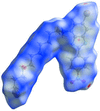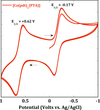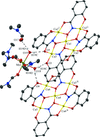issue contents
May 2020 issue

Cover illustration: Push-pull olefins are a class of molecules containing a C=C bond that is conjugated with an electron-donor group on one side and an electron-acceptor substituent on the other side. The compound N-[(Z)-2-(2H-1,3,2-benzodioxaborol-2-yl)-2-phenylethenyl]-N-(propan-2-yl)aniline is a push-pull olefine that was obtained by ynamine hydroboration using a borandiol ester, while judiciously choosing the substituents on the ynamine nitrogen to increase the substrate reactivity. The resulting product comprises an amine as the electron-donating group (EDG), and a boronate as the electron-withdrawing group (EWG). A structural comparison between this compound and similar push-pull olefins through a statistical analysis of bond lengths in their B-C=C-N core units showed that they correlate with the perceived acceptor and donor strength of the groups. See: Gubler & Chen [Acta Cryst. (2020). E76, 710-714].
research communications




































































 journal menu
journal menu



















































